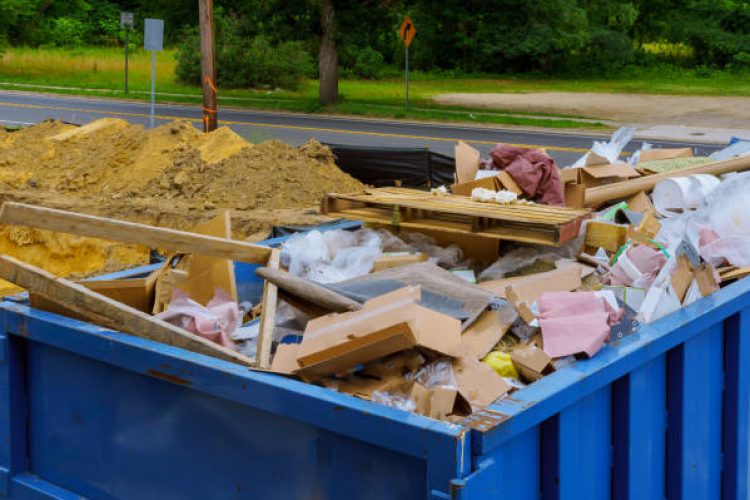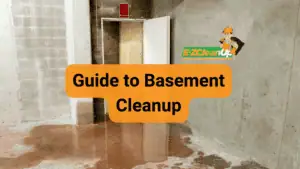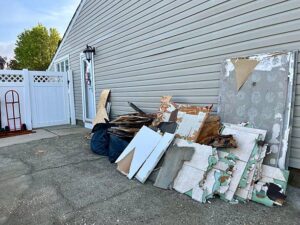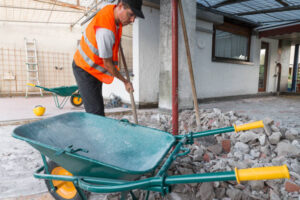Demolition projects generate massive amounts of waste—600 million tons of construction and demolition debris were generated in the United States in 2018. Whether you’re tearing down a residential structure, renovating a commercial building, or conducting selective demolition, integrating strategic junk removal into your demolition workflow can save money, improve safety, and reduce environmental impact.
This comprehensive guide explores how to effectively combine junk removal services with demolition projects for maximum efficiency and sustainability.
Understanding Construction and Demolition Waste
Construction and Demolition (C&D) materials consist of the debris generated during the construction, renovation and demolition of buildings, roads, and bridges. These materials typically include:
- Concrete and masonry
- Wood and lumber
- Metal (steel, copper, aluminum)
- Drywall and plaster
- Roofing materials (asphalt shingles, tiles)
- Fixtures and appliances
- Carpeting and flooring
- Glass and windows
A construction site filled with debris creates safety hazards for workers, potentially leading to injuries, delays, and regulatory violations. Proper debris management ensures clear pathways and workspaces, allowing contractors to operate efficiently and meet crucial project deadlines.
Why Integrate Junk Removal with Demolition?
1. Enhanced Safety
Removing debris progressively throughout the demolition process keeps work areas clear and reduces accident risks. Progressive debris removal maintains organized worksites by removing materials incrementally rather than accumulating waste, improving OSHA compliance and workflow efficiency.
2. Cost Savings
Reduce overall building project expenses through avoided purchase/disposal costs, and the donation of recovered materials to qualified 501(c)(3) charities, which provides a tax benefit. Onsite reuse also reduces transportation costs.
3. Environmental Benefits
Offset the environmental impact associated with the extraction and consumption of virgin resources and production of new materials. Conserve landfill space.
4. Improved Project Timeline
Coordinating junk removal with demolition phases prevents bottlenecks and keeps projects on schedule. For ongoing construction projects, regular cleanup services help maintain site safety and efficiency. Removing debris progressively, rather than waiting until project completion, keeps workspaces organized and reduces accident risks.
Strategic Planning: Before Demolition Begins
Conduct a Pre-Demolition Assessment
Prior to permitting employees to start demolition operations, an engineering survey shall be made, by a competent person, of the structure to determine the condition of the framing, floors, and walls, and possibility of unplanned collapse of any portion of the structure. The employer shall have in writing evidence that such a survey has been performed.
During this assessment, identify:
- Materials that can be salvaged or recycled
- Hazardous materials requiring special handling (asbestos, lead paint, PCBs)
- High-value items for resale or donation
- Best access points for waste removal equipment
Develop a Waste Management Plan
Develop the project schedule to accommodate salvage, reuse, or recycling. The quality and quantity of materials salvaged is a direct function to the time available for salvage.
Your plan should include:
- Material sorting strategy: Separate recyclables from general waste
- Container placement: Position dumpsters strategically for easy access
- Removal schedule: Coordinate pickups to prevent overflow
- Recycling goals: Set targets for diversion from landfills
Deconstruction vs. Traditional Demolition
The Benefits of Deconstruction
Deconstruction is the process of carefully dismantling buildings to salvage components for reuse and recycling. Deconstruction can be applied on a number of levels to salvage usable materials and significantly cut waste.
Ideal candidates for deconstruction include:
- Wood-framed structures
- Buildings with high-quality materials (old-growth timber, unique fixtures)
- Structures with reusable components (doors, windows, cabinetry)
Hybrid Approach
For buildings that do not meet one or more of these criteria, partial deconstruction is an excellent option. In these cases, a combination of deconstruction and demolition can be used.
This approach involves:
- Phase 1: Carefully remove high-value and reusable items
- Phase 2: Systematically demolish remaining structure
- Phase 3: Sort and remove debris for recycling or disposal
Material-Specific Junk Removal Strategies
Wood Materials
Wood cutoffs can be used for cripples, lintels, and blocking to eliminate the need to cut full length lumber. Scrap wood can be chipped on site and used as mulch or groundcover.
Removal options:
- Clean, untreated lumber → Salvage or donate
- Painted/treated wood → Proper disposal at approved facilities
- Scrap wood → On-site chipping for mulch
Concrete and Masonry
Brick, concrete and masonry can be recycled on site as fill, subbase material or driveway bedding.
Removal options:
- Crushing for aggregate
- Reuse as fill material
- Donation to landscaping projects
Metal Components
Metals have significant scrap value and should always be separated for recycling. Professional removal services use environmentally responsible disposal methods.
Drywall and Gypsum
De-papered and crushed gypsum can be used, in moderate quantities, as a soil amendment.
Choosing the Right Junk Removal Service
Full-Service Professional Removal
Professional debris removal services are equipped to manage a wide range of non-toxic construction materials from demolition, remodeling, or new construction projects. These specialized services ensure proper disposal while maximizing recycling opportunities.
Benefits:
- Complete handling from sorting to disposal
- Knowledge of local regulations
- Proper insurance and licensing
- Recycling coordination
Roll-Off Dumpster Rentals
Best for projects where your team handles the sorting and loading. Dumpsters typically range from 10 to 40 cubic yards.
Considerations:
- Weight limits and overage fees
- Permit requirements for street placement
- Prohibited materials restrictions
- Rental duration and pickup scheduling
Compliance and Safety Requirements
OSHA Requirements
Demolition work involves many of the hazards associated with construction; therefore, all of 29 CFR Part 1926 – Construction Standards apply at a demolition site. For this reason, OSHA created the Subpart T – Demolition standards specifically for these operations.
Key requirements include:
- Proper personal protective equipment (PPE)
- Worker training on hazard recognition
- Safe material handling procedures
- Adequate site barricades and signage
Waste Disposal Regulations
Yes, there are regulations governing construction debris removal and disposal. The specific laws and regulations vary by country, state, and locality. However, the overarching goal is to protect public health, safety, and the environment.
Check with local authorities regarding:
- Waste diversion reporting requirements
- Approved disposal facilities
- Recycling mandates
- Hazardous material handling protocols
Best Practices for Combining Junk Removal with Demolition
1. Sort as You Go
Separate materials during demolition rather than creating mixed piles. This maximizes recycling opportunities and reduces disposal costs.
2. Schedule Strategic Pickups
Coordinate removal services to prevent site overflow while minimizing the number of trips.
3. Salvage Before Demolition
Prior to demolition, salvage as much useable material and components as the schedule will allow. Windows and doors, wood flooring, cabinetry, architectural millwork, electrical fixtures, plumbing fixtures, mechanical equipment anything that can be detached and removed can be usually be salvaged and reused.
4. Use Proper Containers
Match container types and sizes to specific materials for efficient handling.
5. Document Everything
Keep records of:
- Materials diverted from landfills
- Recycling weights and volumes
- Donation receipts for tax purposes
- Disposal manifests
Environmental Impact and Sustainability
Maximizing Material Reuse
Some commonly reused C&D materials and applications include: Easy-to-remove items like doors, hardware, appliances, and fixtures. These can be salvaged for donation or use during the rebuild or on other jobs.
Recycling Opportunities
Most construction debris has recycling potential. Wood can be processed into mulch or biomass fuel, while metals hold significant scrap value. Clean concrete becomes aggregate for new projects.
Economic Benefits
EPA’s 2016 Recycling Economic Information (REI) Report showed that in 2012 the recycling of C&D materials created 175,000 jobs.
Cost Considerations
Demolition debris removal costs vary based on:
- Volume: Measured in cubic yards or tons
- Material type: Hazardous materials cost more
- Location: Urban areas typically have higher fees
- Labor: DIY vs. professional services
- Disposal method: Landfill vs. recycling facilities
For residential projects, expect $$300–$$800 per week for a roll-off dumpster rental, with a national range from $280 to $1,550 depending on container size, location, debris type, and weight. Full-service junk removal typically costs $$150–$$450+ per truckload.
Conclusion
Successfully combining junk removal with demolition projects requires careful planning, strategic execution, and commitment to sustainable practices. By implementing progressive debris removal, maximizing material recovery, and partnering with professional junk removal services, you can improve safety, reduce costs, and minimize environmental impact.
Whether you’re managing a small residential teardown or a large commercial demolition, the integration of systematic junk removal throughout the demolition process creates a more efficient, safer, and more sustainable project from start to finish.
References
- U.S. Environmental Protection Agency – Sustainable Management of Construction and Demolition Materials
https://www.epa.gov/smm/sustainable-management-construction-and-demolition-materials - U.S. Environmental Protection Agency – Best Practices for Reducing, Reusing, and Recycling Construction and Demolition Materials
https://www.epa.gov/smm/best-practices-reducing-reusing-and-recycling-construction-and-demolition-materials - OSHA – Demolition Standards and Safety Requirements
https://www.osha.gov/demolition/standards - Whole Building Design Guide – Construction Waste Management
https://www.wbdg.org/resources/construction-waste-management - California Department of Resources Recycling and Recovery (CalRecycle) – Construction and Demolition Debris Recycling
https://calrecycle.ca.gov/condemo/












